Chennai: Evictions in the Name of Road Widening Project Leave Thousands of Residents Displaced
Chennai: On the morning of May 13, a forced eviction took place in the residential area of Karaima Nagar, Pallavaram, Chennai. Carried out in the name of development by the Tamil Nadu state highways department, the eviction was part of a project to widen the 6.8-kilometre Pallavaram-Kundrathur Road from two lanes to four, justifying it by claiming that residents lacked official proof of land ownership.
At dawn on May 13, bulldozers arrived in Karaima Nagar, accompanied by a heavy police presence, to carry out the demolition of homes built over years. Many residents who had left for work returned to find their houses destroyed. The eviction, sudden and carried out without prior notice like many others in recent history, left families with no time to retrieve their belongings.
“I was sitting with my granddaughter when the police came. They dragged us both out, locked the door and began demolishing our home. I couldn’t even change my clothes or take any of our belongings. Important documents like Aadhaar and ration cards were all destroyed. Many of our cats also died under the rubble. Now we have nothing, not even a dress to wear for tomorrow.” says Prema, a resident in Karaima Nagar.
The affected people were not provided with alternative accommodation. For days, many residents were forced to stay amid the ruins of their homes in Chennai’s searing heat.
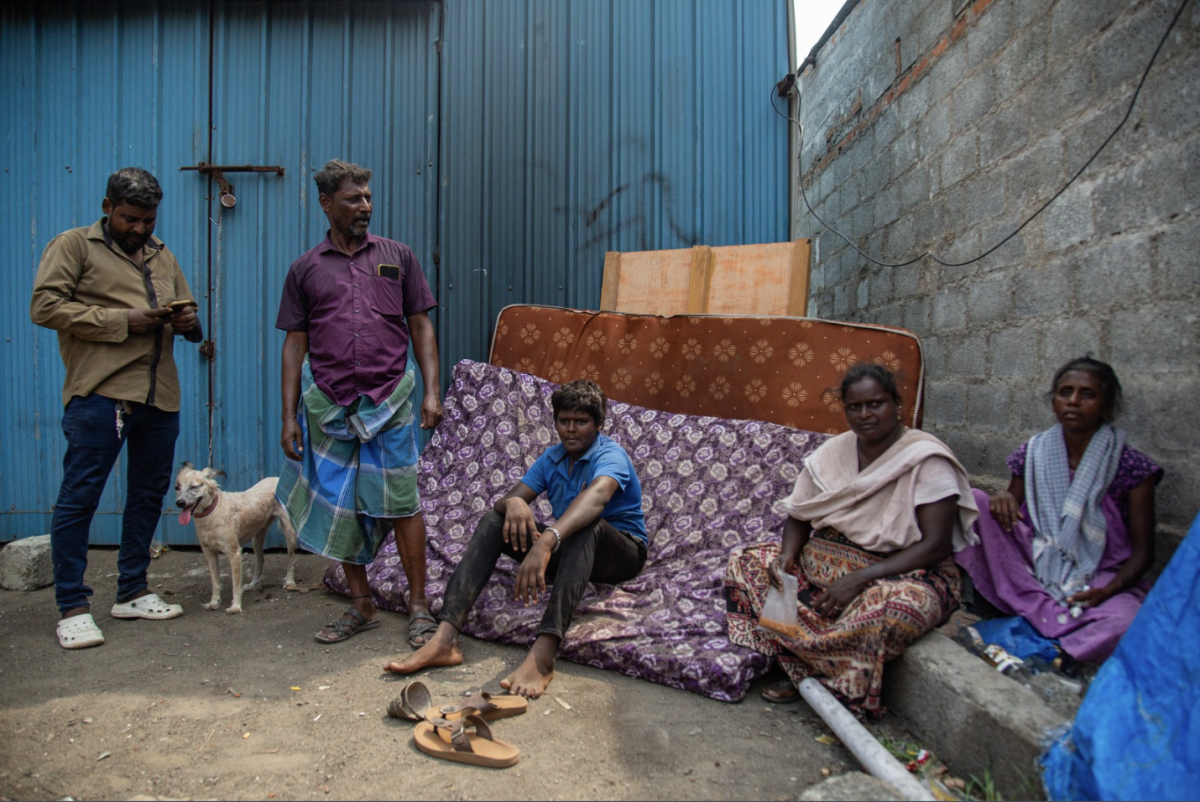
Residents evicted from their home in Karaima Nagar, Pallavaram, Chennai.
“Where are we supposed to use the toilet? There are no nearby public toilets we can access and we can't use open spaces in the heart of the city. We've started drinking less water just to avoid needing the toilet,” says Saroja, another resident.
The residents insist that this is not merely about road widening. Many have alleged that “private real estate interests” particularly the recent arrival of Casagrand and G Square apartment projects have played a crucial role in triggering the eviction.
Notably, this event marks the continuation of evictions in Chennai that began more than a year ago in areas like Karaima Nagar and Anakaputhur, where high-rises and luxury apartments are located nearby. Previously, protests by residents and activists forced authorities to halt the demolitions midway. However, after continuously threatening the residents for over a year, the authorities have now resumed the evictions with the intent to completely erase these residential areas.
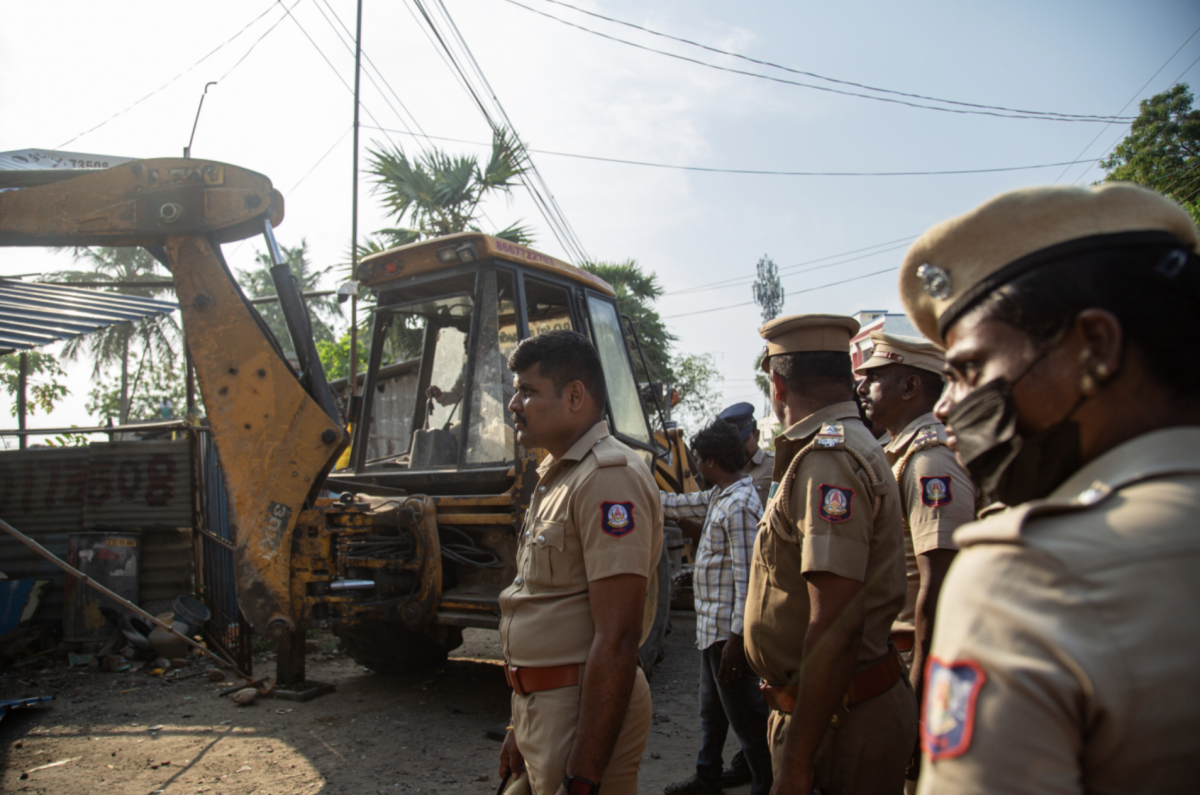
Police and a bulldozer at the site of the evictions in Chennai.
According to residents of Karaima Nagar, owners of these commercial apartments view their hut houses as an eyesore, claiming that it negatively impacted the area's aesthetics and reduced the appeal of nearby commercial buildings. They believe this perception played a key role in their forced displacement.
‘Why only our homes?’
Jeyanthi questions, “If this eviction is really for road widening, why are only our homes being demolished? New apartments are also on the same stretch. Why are they untouched? Is the government widening the four-lane road particularly in our residential area?”
Residents also report that government authorities had promised them a one-month period to vacate. Yet the demolition began the very next day without any formal procedure. There was no proper land measurement, no public hearing and no transparency, residents allege. When they demanded to see a court order for this eviction, the authorities refused to show it to them.
Political betrayal has escalated the residents’s distress. Residents say their area councillor, Madan, had earlier promised resettlement under the Tamil Nadu Slum Clearance Board and warned them to not seek help from others to stop the eviction.
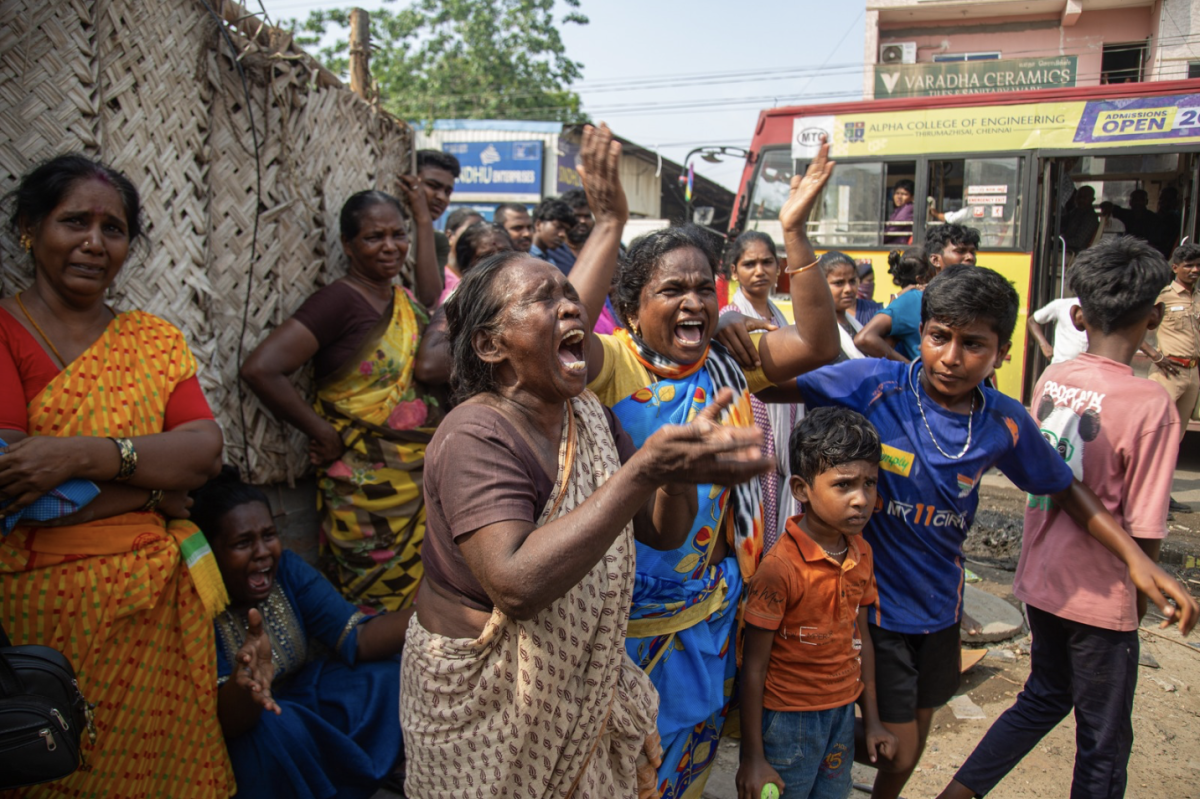
Residents evicted from their home in Karaima Nagar, Pallavaram, Chennai.
“We trusted him. But when the demolition happened, he wasn’t with us in the field. We even went to his house, he was nowhere to be found” claims Rajesh, a resident of Karaima Nagar.
Many residents also alleged that they were verbally abused and intimidated into silence before the eviction by the councillor madan.
The residents possess government-issued documents, such as Aadhaar and ration cards, all registered to this address and have consistently paid taxes for water, electricity and their homes. They question why the government continued to collect taxes from them if it claims they are illegally occupying the land.
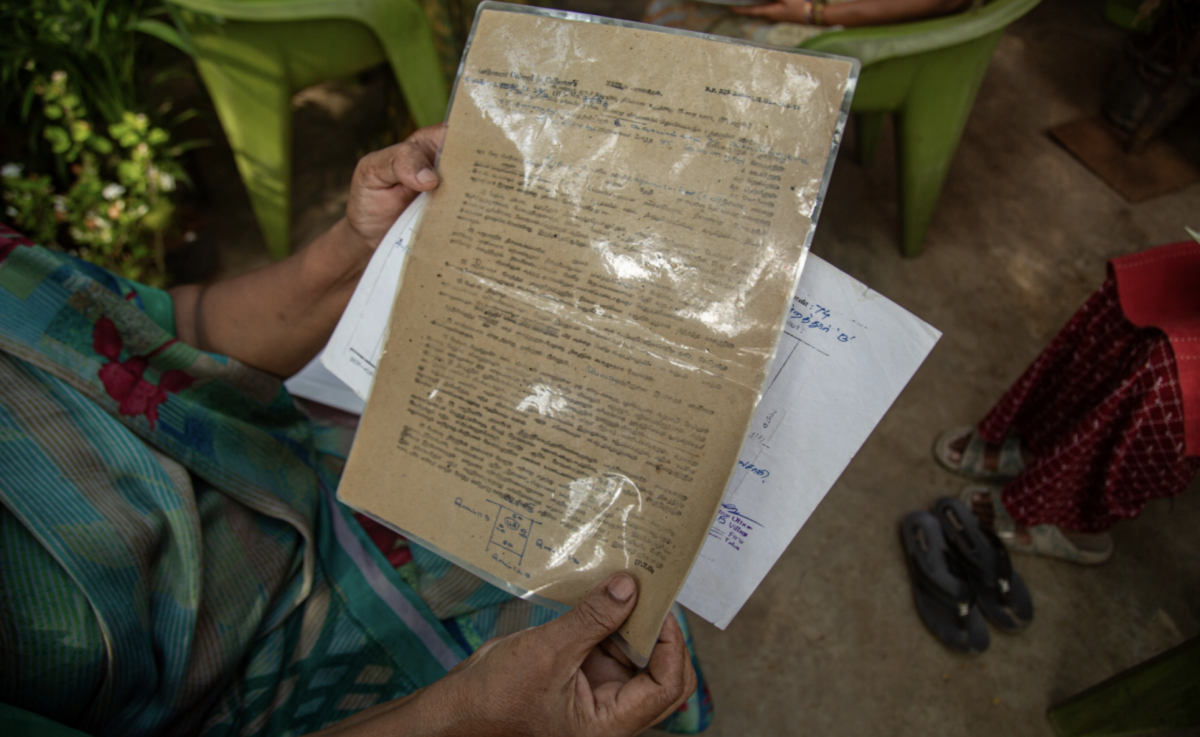
Land documents of a resident in Karaima Nagar, Pallavaram.
In fact, a majority of these families are third-generation residents. Priya, who had lived in a hut house in the area for decades, had only recently built a concrete home. “I worked night shifts and extra hours to save money and build this house. My entire family contributed to its construction. The paint on the walls was still fresh in my house when they demolished it in just a few minutes,” Priya stated.
No alternative
Authorities have justified the eviction under the pretext of legality and urban planning. However, according to the Tamil Nadu Slum Areas (Improvement and Clearance) Act, 1971, the government is required to provide resettlement options before eviction and must obtain the consent of the affected residents.
Instead, what transpired was a sudden, brutal eviction, with no alternative housing provided. The authorities demolished the homes along with people’s belongings, leaving the families homeless, without basic necessities.
When asked about why the eviction was being carried out so hurriedly, an officer with the state highway department responded rudely and refused to answer.
Two days after the eviction, land revenue officers visited the site and assured the affected families that land nearby would be allocated to them within three days, advising them to seek temporary shelter at a nearby school. The families refused to leave, unwilling to abandon their belongings on the open road and relocate at a school with no certainty about their future.
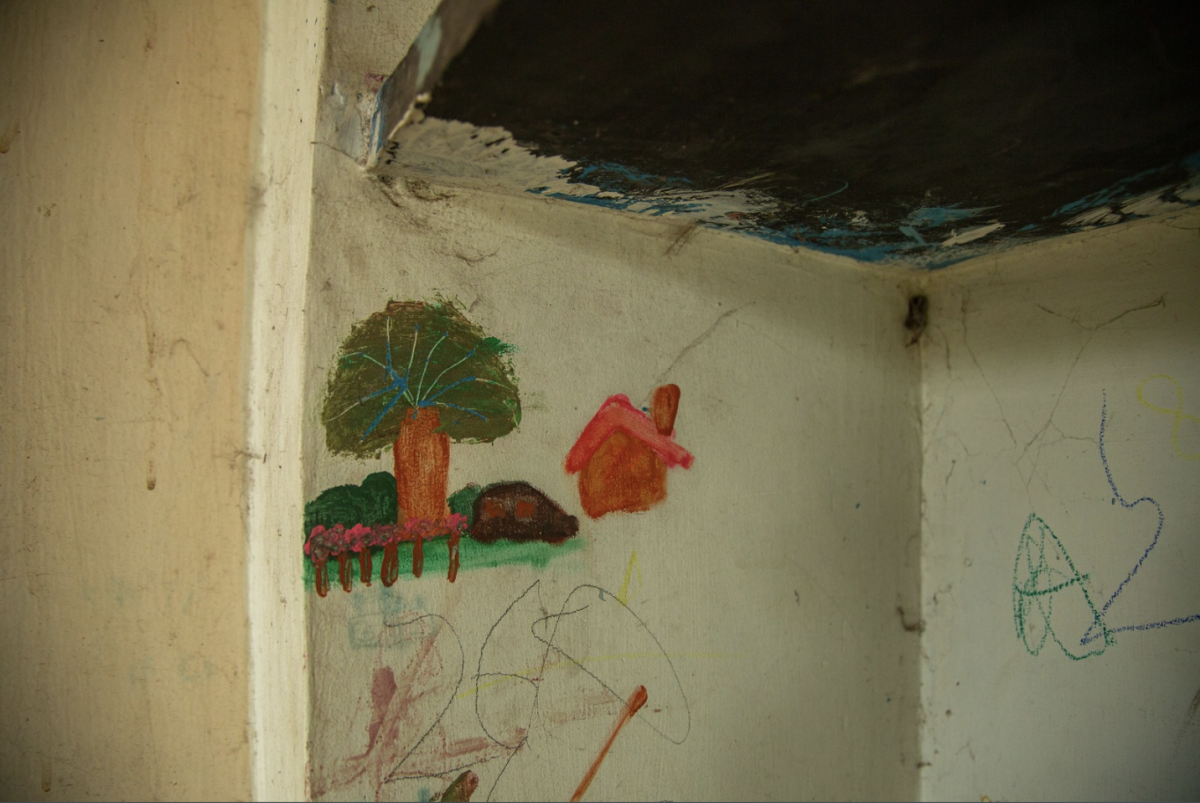
A child's drawing on a wall of a now-demolished home in Karaima Nagar, Pallavaram.
With many residents still sitting on the road, the government continued demolishing the remaining houses, further exacerbating the situation and leaving even more families homeless.
Over a month now, the residents still remain homeless. Authorities recently gave a verbal assurance that the land will be allocated, but there is still no official confirmation.
More evictions underway
Following the Karaima Nagar eviction, demolition also resumed with full force in Anakaputhur and Kaithemillath Nagar areas under the same road widening project. The Tambaram Corporation said that the residents were living too close to the Adyar River and needed to be removed for safety reasons, as well as for road expansion.
Authorities also claimed that the residents lacked proper land documents. So far, more than 1,000 families have been displaced from these three areas.
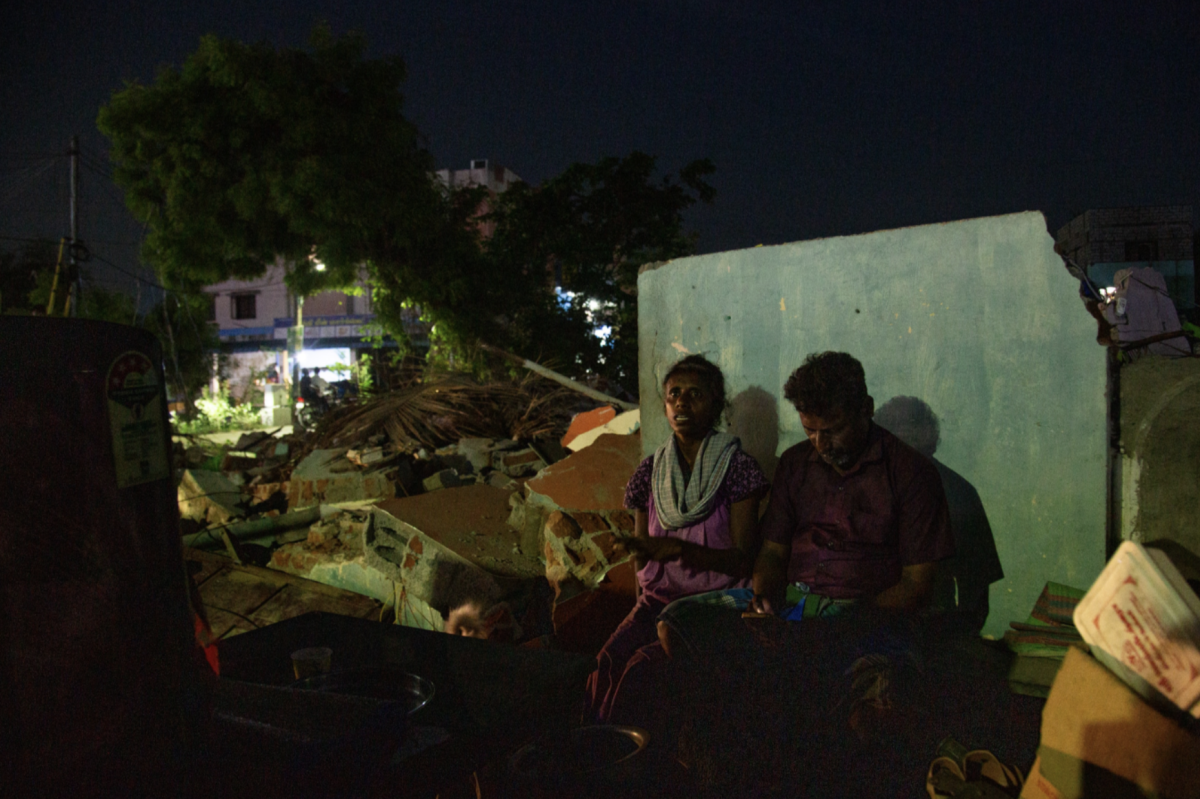
Residents evicted from their home in Karaima Nagar, Pallavaram, Chennai.
However, residents and activists have alleged that the major motive behind all these evictions is to make way for real estate projects, particularly those being built by Casagrand. These housing projects are coming up close to the riverbanks, near the areas where people are being evicted.
The recent demolitions are part of a long, ongoing pattern of evictions in Chennai under the banner of development and beautification. Since the 1990s, Chennai has witnessed relentless displacement, particularly targeting working-class settlements in the name of making the city “slum-free”.
From 2015 to 2020 alone, over 75,000 people across Chennai were forcibly evicted and pushed to the city’s outskirts including Perumbakkam, Ezhil Nagar, Navalur and Athipattu.
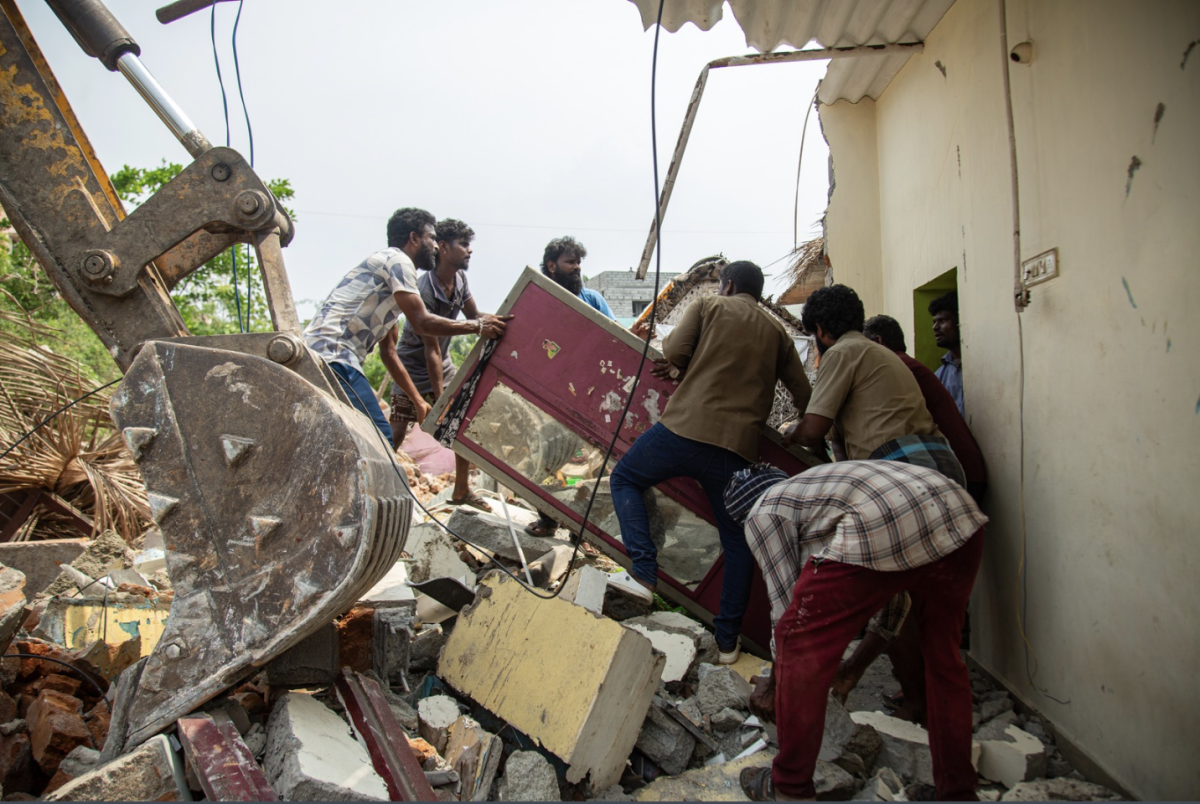
Residents evicted from their home in Karaima Nagar, Pallavaram, Chennai.
After the 2015 floods, mass displacement occurred in the riverbank areas of Chennai. The government at the time had claimed that informal settlements of marginalised communities along the Adyar and Cooum rivers and Buckingham Canal were responsible for the floods.
However, IT parks and luxury apartments built on wetlands in Velachery were not subject to the same scrutiny.
The outskirt resettlement buildings lack vital services like transportation, schools, healthcare and access to clean water. Most residents of these buildings are unable to find work due to the distance from their places of employment. “I worked as a domestic helper before the relocation. I lost my job after we were relocated. I have been unemployed for more than a year,” says Sathya, a resident from Anakaputhur, Pallavaram, who was displaced last year.
Furthermore, most of the resettlement areas are themselves susceptible to flooding. If the government states that the purpose of slum clearance is to provide safer and more reliable living conditions for people in vulnerable places, uprooting them to equally precarious situations invalidates the reason for the eviction.
Hairunisha is a photography intern at The Wire.
This article went live on June twenty-first, two thousand twenty five, at fifty-five minutes past eight in the evening.The Wire is now on WhatsApp. Follow our channel for sharp analysis and opinions on the latest developments.




